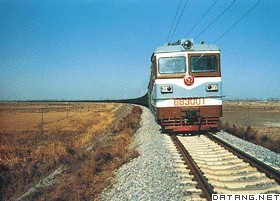1) industrial rail transport management


工业铁路运输管理
2) railway industry


铁路运输业
1.
The statistical index system of the railway industry is the core carrier of railway statistics.
铁路运输业统计指标体系是铁路运输统计工作的核心载体。
2.
It is the end purpose of the whole reformations to lead the competition into the railway industry to increase its efficiency.
为铁路运输业引入竞争以提高其效率,是一切改革方案的最终目的。
3.
Statistical index system of Chinese railway industry is the core carrier of railway statistics.
铁路运输业统计指标体系是铁路运输统计工作的核心载体。
3) railway transport industry


铁路运输业
1.
Study of Developing the Modern Logistics of China Railway Transport Industry;


中国铁路运输业发展现代物流的思考
2.
Analysis on the necessity of the study on administrative monopoly in railway transport industry——Based on the arrangement of existed related literatures
铁路运输业行政垄断问题研究的必要性分析——基于对已有相关文献的梳理
3.
Scholars from abroad have studied the railway transport industry from various angles and have acquired a lot of academic achievements for our references.
国外学者当前已经从多个角度对铁路运输业进行了研究,并取得了大量可供参考的学术成果。
4) railway transportation


铁路运输业
1.
The article first introduces the challenge which the railway transportation faces after entering into the WTO.
本文就入世给我国铁路运输业带来的挑战 ,探讨了入世后可能带来的机遇 ,并针对上述挑战和机遇 ,从两个方面提出相应的对策和建
5) ERTMS


欧洲铁路运输管理系统
1.
The essay introduces the development status of ERTMS/ETCS and research status at home and abroad, presents the basicframe of CTCS from the situation of China, analyzes the status and problems of developing CTCS in China, and puts forward suggestionson developing China train control system.
介绍欧洲铁路运输管理系统和欧洲列车控制系统(ERTMS/ETCS)的发展状况,从我国国情出发,介绍中国列车控制系统(CTCS)的基本框架,并分析我国铁路发展CTCS现状及面临的问题,提出发展该系统的若干建议。
6) Railway Transportation Dispatching Management System


铁路运输调度管理系统
1.
There were many professions and sub-systems in Railway Transportation Dispatching Management System, the complicity of business resulted in the complicity of sub-system.
铁路运输调度管理系统涵盖了多个工种和应用子系统,业务的复杂性决定了多个子系统之间的多重交互。
补充资料:铁路运输
| 铁路运输 railway transportation 由机车牵引的车厢载运旅客或货物的一种有轨运输方式。在现代陆运运输方式中,铁路运输占有重要的地位,在不少国家是客、货运输的主要方式。世界上大多数国家均建有铁路。按营运里程的长短,前10名国家依次是美国、独联体、加拿大、印度、中国、德国、法国、日本、英国和意大利。 自1825年在英国出现斯托克顿-达灵顿铁路后 ,迄今铁路运输已有170年的历史。19世纪20年代的美国和法国、30年代的俄国和德国都修建了铁路。至50年代,欧洲和北美的绝大部分国家也都修建了铁路。20世纪20年代世界铁路营运里程已达100余万千米 ,到40年代就增长到125万千米。此后,由于运输市场的竞争,虽然修建了一些新线路,但也淘汰了一些效益差的线路。至80年代,世界铁路营运里程仍未突破130万千米。主要分布在欧洲、北美洲和亚洲,分别占世界铁路总营运里程的1/3、1/3和1/7左右。 中国最早的铁路是英商于1876年修建的上海至吴淞的淞沪铁路,全长15千米左右,为窄轨铁路。最早的标准轨铁路是1881年修建的唐山至胥各庄的唐胥铁路。截至1994年,中国铁路总里程增至53992千米,年完成货运量157155万吨、货物周转量12457亿吨千米、客运量108738万人、旅客周转量3636亿人。根据九五计划,到2000年铁路总里程将达6.8万千米,货运量将达到18亿吨。 铁路运输的各种设施可分为两大类:固定设施和活动设备。固定设施包括列车运行的线路结构、车站、库场、通信及信号系统、供电、供水系统及维修设施等;活动设备主要是牵引机车和客、货车等。线路是列车行驶的基础设施,主要由路基、道床、轨枕和钢轨(见轨道)等构成。铁路的营运组织工作在铁路运输中具有十分重要的地位,它将保证运输各环节的协调一致和安全、正点、经济地完成运输任务。
铁路运输具有许多优越性:运输成本低,运量愈大,运距愈长,单位成本愈低;运输能力大,大宗散货运输的列车总重可超过万吨,旅客列车可载运千人以上,双线铁路昼夜列车通过能力可超过百余对,单向年货物通过能力可在亿吨以上;耗能少,单位功率牵引效率可比汽车高10倍;行驶速度高,普通列车每小时车速可达百千米左右,高速列车每小时可达300千米以上;有灵活性 ,可以实现大型企业、厂矿的由起点直达终点的门到门运输。 |
说明:补充资料仅用于学习参考,请勿用于其它任何用途。
参考词条
